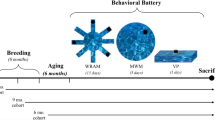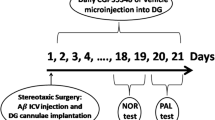Abstract
Decreases in cognitive functions, particularly long-term (episodic) and working memory, are among the earliest prognostic signs of Alzheimer’s disease. The toxicity of β-amyloid peptide is regarded as a major cause of neurodegeneration and cognitive impairment in this disease. The present report describes studies of the effects of intracerebroventricular administration of β-amyloid peptide (25–35) (Aβ(25–35)) on the reproduction of a previously assimilated habit consisting of finding food in an eight-arm radial maze in rats. Aβ (25–35) was given bilaterally at doses of 15 and 30 nmol/animal seven days after preliminary training. Testing was performed 60 days after peptide administration. The results showed that Aβ(25–35) impaired working memory in rats without having any significant effect on the retention of responses. We were unable to demonstrate any relationship between memory impairment and the dose of peptide given. These data provide evidence of the ability of Aβ(25–35) to produce greater degradation of working memory function than long-term memory function.
Similar content being viewed by others
REFERENCES
O. S. Mitrokhina, M. Yu. Stepanichev, N. A. Lazareva, et al., “The effects of intracerebroventricular administration of fragment (25–35) of beta-amyloid peptide on the level of lipid peroxidation in rat brain structures and blood,” Dokl. Ros. Akad. Nauk., 368, No.5, 711–713 (1999).
M. Yu. Stepanichev, N. A. Lazareva, M. V. Onufriev, et al., “The effects of administration of fragment (25–35) of beta-amyloid peptide on behavior in rats,” Zh. Vyssh. Nerv. Deyat., 47, No.3, 597–600 (1997).
M. Yu. Stepanichev, Yu. V. Moiseeva, and N. V. Gulyaeva, “‘Injection’ models of Alzheimer’s disease: oxidative stress in the mechanism of toxicity AF64A and β-amyloid peptide in rodents,” Neirokhimiya, 19, No.3, 165–175 (2002).
M. Yu. Stepanichev, M. V. Onufriev, O. S. Mitrokhina, et al., “Neurochemical, behavioral, and neuromorphological effects of central administration of beta-amyloid peptide (25–35) in rats,” Neirokhimiya, 17, No.4, 291–306 (2000).
V. V. Trubetskaya, M. Yu. Stepanichev, M. V. Onufriev, et al., “Administration of aggregated beta-amyloid peptide (25–35) induces changes in long-term potentiation in the hippocampus in vivo,” Zh. Vyssh. Nerv. Deyat., 51, No.6, 701–704 (2001).
E. Abe, F. Casamenti, L. Giovannelli, et al., “Administration of amyloid beta-peptides into the medial septum of rats decreases acetylcholine release from hippocampus in vivo,” Brain Res., 636, 162–164 (1994).
A. Baddeley, “The fractionation of working memory,” Proc. Natl. Acad. Sci. USA, 93, 13468–13472 (1993).
G. T. Bartoo, D. Nochlin, D. Chang, et al., “The mean Aβ load in the hippocampus correlates with duration and severity of dementia in subgroups of Alzheimer disease,” J. Neuropathol. Exp. Neurol., 56, 531–540 (1997).
S. Y. Chen, J. W. Wright, and C. D. Barnes, “The neurochemical and behavioral effects of beta-amyloid peptide (25–35),” Brain Res., 720, 54–60 (1996).
J. J. Chrobak, I. Hanin, D. E. Schmechel, and T. J. Walsh, “AF64A-induced working memory impairment: behavioral, neurochemical and histological correlates,” Brain Res., 463, 107–117 (1988).
R. F. Cowburn, B. Wiehager, E. Trief, et al., “Effects of β-amyloid-(25–35) peptides on radioligand binding to excitatory amino acid receptors and voltage-dependent calcium channels: evidence for a selective affinity for glutamate and glycine recognition sites of the NMDA receptor,” Neurochem. Res., 22, 1437–1442 (1997).
W. K. Cullen, Y.-H. Suh, R. Anwyl, and M. J. Rowan, “Block of LTP in rat hippocampus in vivo by β-amyloid precursor protein fragments,” Neuroreport, 8, 3213–3217 (1997).
S. Delobette, A. Privat, and T. Maurice, “In vitro aggregation facilitates beta-amyloid peptide-(25–35)-induced amnesia in the rat,” Eur. J. Pharmacol., 319, 1–4 (1997).
D. W. Dickson, H. A. Crystal, L. A. Mattiace, et al., “Identification of normal and pathological aging in prospectively studied nondemented elderly humans,” Neurobiol. Aging, 13, 179–189 (1992).
L. Giovanelli, F. Casamenti, C. Scali, et al., “Differential effects of amyloid peptides β-(1–40) and β-(25–35) injections into the rat nucleus basalis,” Neurosci., 66, 781–792 (1995).
N. V. Gulyaeva, I. V. Victorov, M. Yu. Stepanichev, et al., “Intracerebroventricular administration of beta-amyloid peptide (25–35) induces oxidative stress and neurodegeneration in rat brain,” in: Progress in Alzheimer’s and Parkinson’s Diseases, A. Fisher et al. (eds.) Plenum Press, New York (1998), pp. 89–98.
T. Harkany, J. Mulder, M. Sasvan, et al, “N-methyl-D-aspartate receptor antagonist MK-801 and radical scavengers protect cholinergic nucleus basalis neurons against β-amyloid neurotoxicity,” Neurobiol. Dis., 6, 109–121 (1999).
K. Hsiao, P. Chapman, S. Nilsen, et al., “Correlative memory deficits, Aβ elevation, and amyloid plaques in transgenic mice,” Science, 274, 99–102 (1996).
R. Katzman, R. Terry, R. DeTeresa, et al., “Clinical, pathological, and neurochemical changes in dementia: a subgroup with preserved mental status and numerous neocortical plaques,” Ann. Neurol., 23, 138–144 (1988).
H. Lin, R. Bhatia, and R. Lal, “Amyloid (beta) protein forms ion channels: implications for Alzheimer’s disease pathophysiology,” FASEB J., 15, 2433–2444 (2001).
Y. Luo, D. B. Hawyer, K. Iwasaki, et al., “Physiological levels of β-amyloid peptide stimulate protein kinase C in PC12 cells,” Brain Res., 769, 287–295 (1997).
M. P. Mattson, “Modification of ion homeostasis by lipid peroxidation: roles in neuronal degeneration and adaptive plasticity,” Trends Neurosci., 21, 53–57 (1998).
M. P. Mattson, S. W. Barger, B. Cheng, et al., “β-Amyloid precursor protein metabolites and loss of neuronal Ca2+ homeostasis in Alzheimer’s disease,” Trends. Neurosci., 16, 409–414 (1993).
T. Maurice, B. P. Lockart, and A. Privat, “Amnesia induced in mice by centrally administered beta-amyloid peptides involves cholinergic dysfunction,” Brain Res., 706, 181–193 (1996).
M. P. McDonald, E. E. Dahl, Y. B. Overmeier, et al., “Effects of an exogenous β-amyloid peptide on retention for spatial learning,” Behav. Neural. Biol., 62, 60–67 (1994).
M. P. McDonald, E. E. Dahl, Y. B. Overmeier, et al., “Reversal of β-amyloid-induced retention deficit after exposure to training and state cues,” Neurobiol. Learn. Mem., 65, 35–47 (1996).
M. P. McDonald and Y. B. Overmeier, “Present imperfect: a critical review of animal models of mnemonic impairments in Alzheimer’s disease,” Neurosci. Biobehav. Rev., 22, 99–120 (1998).
R. G. M. Morris, “Episodic-like memory in animals: psychological criteria, neural mechanisms and the value of episodic-like tasks to investigate animal models of neurodegenerative disease,” Phil. Trans. Roy. Soc. Lond., 356, 1453–1463 (2001).
J. Naslund, V. Haroutunian, R. Mohs, et al., “Correlation between levels of amyloid beta-peptide in the brain and cognitive decline,” J. Amer. Med. Assoc., 283, 1571–1577 (2000).
A. Nitta, A. Itoh, T. Hasegawa, and T. Nabeshima, “β-amyloid protein-induced Alzheimer’s disease animal model,” Neurosci. Lett., 289, 63–66 (1994).
A. Olariu, M. H. Tran, K. Yamada, et al., “Memory deficits and increased emotionality induced by beta-amyloid (25–35) are correlated with the reduced acetylcholine release and altered phorbol dibutyrate binding in the hippocampus,” J. Neural Transm., 108, 1065–1079 (2001).
D. S. Olton, “Spatial memory,” Sci. Amer., 236, 82–98 (1977).
S. O’Mahony, T. Harkany, A. A. M. Rensink, et al., “β-amyloid-induced cholinergic denervation correlates with enhanced nitric oxide synthase activity in rat cerebral cortex: Reversal by NMDA receptor blockade,” Brain Res. Bull., 45, 405–411 (1998).
G. Paxinos and C. Watson, The Rat Brain in Stereotaxic Coordinates, Academic Press, Sidney (1982).
C. J. Pike, D. Brudick, A. J. Walencevicz, et al., “Neurodegeneration induced by β-amyloid peptides in vitro: the role of peptide assembly state,” J. Neurosci., 13, 1676–1687 (1993).
D. J. Selkoe, “Alzheimer’s disease: genes, proteins, and therapy,” Physiol. Rev., 81, 741–766 (2001).
A. Stephan, S. Laroche, and S. Davis, “Generation of aggregated β-amyloid in the rat hippocampus impairs synaptic transmission and plasticity and causes memory deficits,” J. Neurosci., 21, 5703–5714 (2001).
W. Sweeney, J. Luedtke, M. P. McDonald, and J. B. Overmeier, “Intrahippocampal β-amyloid impairs win-shift radial maze performance in rats,” Neurobiol. Learn. Mem., 68, 97–101 (1997).
J. P. Terranova, J. P. Kan, J. J. Storme, et al., “Administration of amyloid beta-peptides in the rat medial septum causes memory deficits: reversal by SR 57746A, a non-peptide neurotrophic compound,” Neurosci. Lett., 213, 79–82 (1996).
L. Tong, P. L. Thornton, R. Balazs, and C. W. Cotman, “β-Amyloid-(1–42) impairs activity-dependent cAMP-response element-binding protein signalling in neurons at concentrations in which cell survival is not compromised,” J. Biol. Chem., 276, 17301–17306 (2001).
M. H. Tran, K. Yamada, A. Olariu, et al., “Amyloid β-peptide induces nitric oxide production in rat hippocampus: association with cholinergic dysfunction and amelioration by inducible nitric oxide synthase inhibitors,” FASEB J., 15, 1407–1409 (2001).
M. A. Westerman, D. Cooper-Blacketer, A. Mariash, et al., “The relationship between Aβ and memory in the Tg2576 mouse model of Alzheimer’s disease,” J. Neurosci., 22, 1858–1867 (2002).
Y. Yamaguchi and S. Kawashima, “Effects of amyloid-β-(25–35) on passive avoidance, radial-arm maze learning and choline acetyltransferase activity in the rat,” Eur. J. Pharmacol., 412, 265–272 (2001).
B. A. Yankner, L. K. Duffy, and D. A. Kirschner, “Neurotrophic and neurotoxic effects of amyloid β protein: reversal by tachykinin neuropeptides,” Science, 250, 279–282 (1990).
Author information
Authors and Affiliations
Additional information
Translated from Zhurnal Vysshei Nervnoi Deyatel’nosti, Vol. 54, No. 3, pp. 382–389, May–June, 2004.
Rights and permissions
About this article
Cite this article
Stepanichev, M.Y., Moiseeva, Y.V., Lazareva, N.A. et al. Studies of the effects of fragment (25–35) of beta-amyloid peptide on the behavior of rats in a radial maze. Neurosci Behav Physiol 35, 511–518 (2005). https://doi.org/10.1007/s11055-005-0086-1
Received:
Accepted:
Issue Date:
DOI: https://doi.org/10.1007/s11055-005-0086-1




